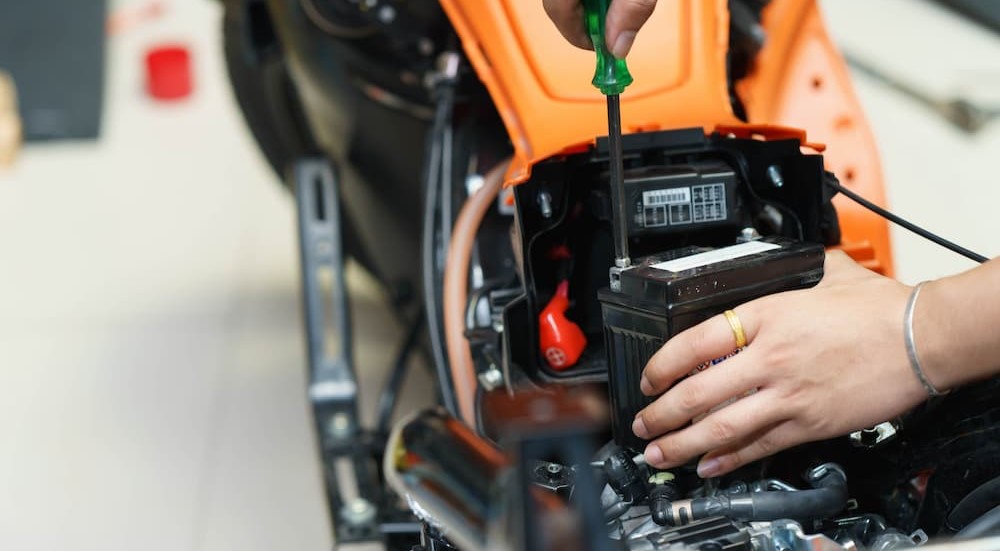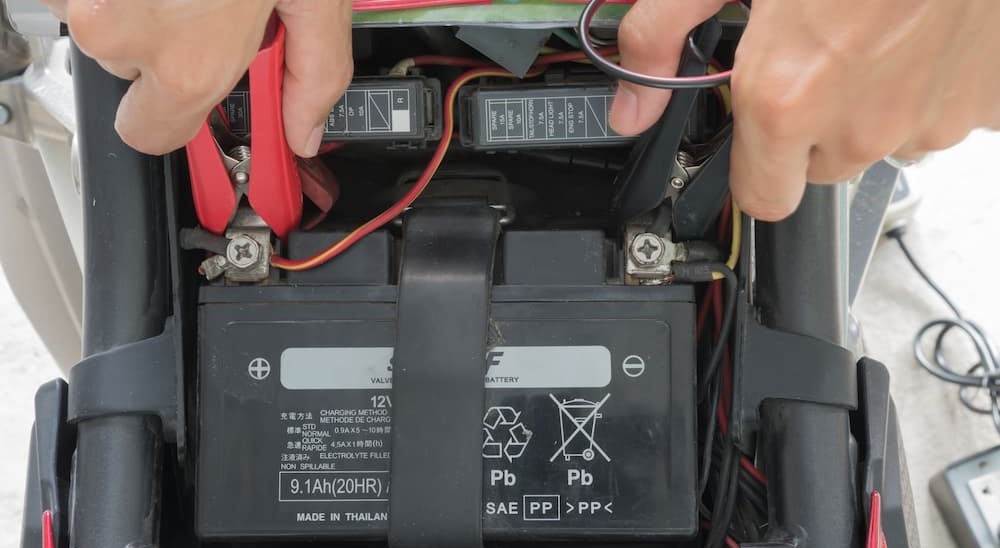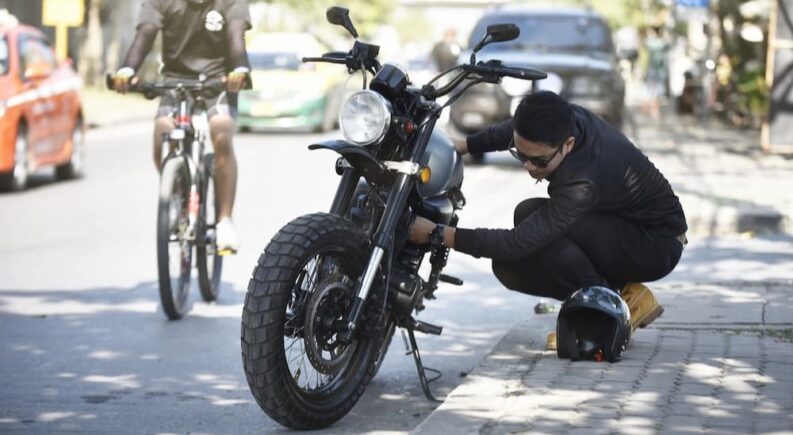Whether you’re into carving through curves and opening up the throttle or leaning back and enjoying a nice, relaxed cruise, motorcycle riders spend countless hours dreaming about their next ride. That anticipation can quickly turn into frustration when the bike is stubborn, which is why every rider should know what to do if their motorcycle won’t start.
In the most basic terms, a motorcycle needs three things to get started: fuel, compression, and a spark. While some starting-related issues are wholly unique to the world of motorcycles, these three factors are usually a good place to start when it comes to any gas-powered vehicle. Let’s examine some of the more obvious trouble areas like the battery and spark, compression, and spark-related issues, then dive into some of the motorcycle-specific problems that could be to blame. Starting problems are par for the course with any gas-powered vehicle, but by developing some good habits and knowing what to look for, it’s easy to increase your chances of your next ride going off without a hitch.
Battery
We’ll start with one of the most common culprits for a motorcycle that won’t start: the battery. Whether it’s due to low temperatures, power-hungry accessories left on overnight, or normal wear-and-tear, a dead battery can be a major roadblock when it comes to enjoying your next ride.
A dead or dying battery will usually present some pretty common symptoms. Riders might notice dim headlights, that their starter sounds a little half-hearted, or the absence of any starting action at all as turning the key results in some telltale clicks. If your bike isn’t exhibiting these signs, it’s time to dig a little deeper.
Start by examining the battery terminals to ensure they’re properly connected and undamaged. A loose connection, a damaged terminal, or a terminal that’s crusted over with corrosion will hamper the amount of juice being fed to the bike. Next, inspect the battery for fluid leaks, cracks, or bumpy protrusions. If you spot any of these symptoms, it’s well past time for a new battery.
If a visual inspection of your battery doesn’t turn up any obvious defects, it’s time to whip out your voltmeter. A healthy battery should show a reading of between 12.7 and 13.6 volts. If you don’t have a voltmeter handy, your local auto parts store will typically perform the test for free. If your battery’s voltage falls within the expected range and it has passed all the other tests, your starting issues are likely unrelated to the battery itself. If, on the other hand, your battery does seem to be a little low on power, it’s time for a recharge.
Jump Starting a Motorcycle
In some cases, jump-starting a motorcycle is slightly different from jumping-starting a car, truck, or SUV. If you have a portable jump starter or donor bike to draw a little power from, the process is largely the same, but riders should always use caution when jumpstarting their motorcycle from a traditional four-wheeled vehicle. These vehicles are designed to withstand more electrical power than motorcycles, so employing the traditional jump-start method can result in a fried electrical system. To ensure this doesn’t happen, it’s important to remember not to start the donor car’s engine. Instead, connect the cables as you would for a typical jump start, then just wait. Power will slowly transfer from the healthy battery to the dead one, but turning over that ignition can cause things to go sideways in a hurry.
If you don’t have access to another motorcycle, portable jump starter, or car battery, and your bike is just a little short on power, there’s always the good old bump start. If you can get your bike rolling down a hill or have friends who can give you a little push, you can use the mechanical energy of the rotating rear wheel to help turn over the engine. Put the bike in neutral, engage the ignition, and once you get moving at a decent speed, pop the clutch and shift the motorcycle into second gear. Bounce down on the seat as hard as possible to prevent skidding and increase traction while dumping the clutch. It might take a little practice, but if you can master this technique, you may save yourself that dreaded call to roadside assistance.
Even if your non-starting motorcycle can’t be attributed to a dead battery, it can easily become another issue you must deal with. When their bikes don’t start, many riders keep cranking the starter until the battery is drained. This means they’ll have to address the initial problem as well as recharge the battery before setting off on their next journey. If your bike doesn’t start after the first few cranks, take a breath and consider other culprits before compounding your dilemma.

Spark Plugs
If your battery is fine, but the engine still won’t fire, it’s time to check on the spark plugs. Responsible for initiating the combustion cycle, old, worn-out, or dirty spark plugs can lead to plenty of problems when you’re trying to get your day in gear. In a traditional vehicle, drivers can easily go up to 30,000 miles before changing over their spark plugs, but motorcycles are a different beast altogether, as most experts recommend riding no more than 8,000 to 10,000 miles before investing in a new set.
Giving your spark plugs a check-up is one of the easier tasks a rider will encounter. Simply remove the spark plugs and do a quick visual inspection, keeping an eye out for any cracks in the ceramic coating or dark, oily deposits on the tip. If there are no obvious problems, it’s time for a little test. Remove each spark plug from the cylinder, reattach the plug cap, and then place the head of the spark plug near some metal surface. When you crank the engine, you should notice a distinctive blue-white spark jumping between the plug and the metal. If the spark is weak, orange and flame-like, or simply non-existent, you could be looking at a spark plug at the end of its natural service life.
If replacing the spark plugs with a fresh set doesn’t solve the problem, the issue might lie deeper within your bike’s electrical system. Inspect the plug boot and wiring for any conspicuous wear and tear. If that doesn’t turn up any suspects, grab a multimeter and begin testing your plugs, wires, ignition coil, capacitor discharge ignition (CDI) box, and rectifier/regulator. Any of these could prevent power from getting to your spark plugs, resulting in a no-start condition.
Fuel
Fuel is an important part of the equation in any internal combustion vehicle. It should never be overlooked when trying to get to the bottom of a non-starting motorcycle. The issue could be simple, like forgetting to turn on your fuel valve, or something relatively complex like the carburetor or fuel pump, float-bowl height, or an air leak. As always, it pays to start with some of the more obvious causes. We’re certainly not trying to insult anyone’s intelligence, but something as simple as checking that there’s actually fuel in the tank can save you a little time and a lot of embarrassment when trying to diagnose a starting issue.
Just because there’s fuel in the tank doesn’t necessarily mean that it’s good fuel. In areas with real winters and cold weather, motorcycles see long periods of inactivity due to low temperatures or slick road conditions. These furloughs can lead to stale, ineffective fuel, which can break down and lose its effectiveness in just 30 days. If you don’t remember the last time you filled up, a little smell test can go a long way. Fresh gas will sting the nostrils and have a familiar odor, while stale gas will produce a much milder and sweeter scent. A little fuel stabilizer can help to keep the gas fresh over a longer period of time, so before putting your bike away for the winter, grab a bottle and increase your chances of a smooth start in the spring.
If the fuel itself doesn’t seem to be the issue, your next step should be checking in on the fuel pump or carburetor. On a fuel-injected bike, when you insert the key, flip the kill switch, and put the kickstand up, you should notice a slight hum from the fuel pump, which is usually located right under the gas tank. If the area is noticeably quiet, take a closer look at the fuel pump fuse and ensure the tip-over sensor and side stand switch are in the correct position. A clogged petcock could also be to blame, as it controls the flow of fuel through the system.
The process is a little different when dealing with a carburetor-fed fuel system. If you’re mechanically inclined, feel free to check the fuel and vacuum lines for cracks and tears, especially if the bike has been stored for a long time. A little cleaning can also go a long way towards alleviating the issue, so if there’s noticeable green gunk in the carburetor, try spraying it with a little starting fluid or carburetor cleaner. A clogged petcock could also be to blame, as it controls the flow of fuel through the system. The air and fuel filters could be an issue as well, which is why keeping up with your bike’s recommended maintenance schedule is so important.
Compression
Finally, there’s compression. For the combustion process to be effective, it needs to take place in a tightly sealed chamber with enough compression to ignite the air-fuel mixture properly. When this seal is compromised due to worn pistons, cylinders, piston rings, or compromised crank seals and head gaskets, it can lead to all sorts of issues, including a bike that just won’t start. Unfortunately, addressing an engine’s compression is far from the easiest or cheapest task on the docket. Replacing worn seals, pistons, cylinders, and gaskets can require a thorough engine tear-down, resulting in a hefty bill thanks to the labor involved.
If the engine is still turning over, riders can perform a compression test that can help narrow down the issue to a specific cylinder or component. A healthy engine should create between 150 to 200 psi of pressure, with a sub-100 reading signaling an obvious compression-related problem. This diagnostic process isn’t an option when you can’t get the bike to crank in the first place. This usually means it’s time to call in the experts, though in some cases, the solution might be as simple as replacing a clogged air filter.

Other Issues
While problems with fuel, compression, and spark are the most common reasons why an engine won’t start, there are a few others worth checking if your diagnosis so far hasn’t turned up any obvious problems.
Kill Switch
A kill switch is an important feature in any modern motorcycle. Designed to shut off the engine in case of a crash or fall, the kill switch uses sensors to determine if the bike is upright. After it has been engaged, the kill switch must be manually disengaged for the bike to go through its proper start-up procedure. Failing to flick the switch back to the “on” or “run” position might sound pretty obvious, but it can be easy to overlook when trying to solve the mystery of the non-starting motorcycle.
Side Stand
Many bikes are built with a safety mechanism that prevents the engine from starting when the side stand is deployed. Again, this should be fairly obvious, but you would be far from the first rider to struggle with a starter only to sheepishly notice that the side stand was still down. A side stand can also become stuck in position after a long period of inactivity, but a little lubricant can go a long way in alleviating the issue. In rare cases, the side stand sensors might read the stand as being deployed when it’s not, which can also lead to problems.
Clutch
If you skipped Motorcycle 101 or have simply taken an extended break from the two-wheeled lifestyle, refreshing yourself on the basics can take some time. For most motorcycles to start, riders must pull the clutch lever while the transmission is in neutral. If your clutch switch has sustained a little damage, pumping the clutch could help to alleviate the issue, though it’s usually not a long-term solution.
Choke
On older carburetor-fed bikes, solving your starting issues might be as simple as toggling the choke. This is an especially common issue when the weather is chillier, requiring a richer fuel mixture than one might get away with on a warmer day. Closing the choke results in less airflow, increasing the fuel side of the fuel-to-air ratio and enabling easier starts on colder days. This can also help engines that haven’t run for a while.
Muffler
A clogged muffler can create some headaches when starting a motorcycle, especially if it’s been sitting around for a while. Under normal circumstances, a muffler shouldn’t get clogged during normal operation, but when you put your bike into storage, it can quickly become a nesting ground for small creatures like rodents looking for a nice, safe space to hibernate. Serve these stowaways with their eviction notice and see if that solves your starting issue.
There’s nothing quite as frustrating as trying to start your motorcycle and being met with an unresponsive bike. A little routine maintenance can go a long way in preventing this sort of scenario. Every motorcycle (along with every car, truck, and SUV) comes with an owner’s manual that includes a thorough maintenance schedule. Sticking to this schedule and performing all the recommended maintenance is an easy way to ensure smooth, consistent starts. The maintenance schedule will outline recommended service and replacement intervals for key motorcycle components, including the spark plugs, battery, filters, and more. While it’s no guarantee that you won’t experience a rough start, it’ll improve your odds and make it easier to narrow down the issue if your bike encounters some problems. Remember, always start by checking some of the easier, more obvious suspects, and don’t be afraid to call in a little help if you ever feel like you’re in over your head.

